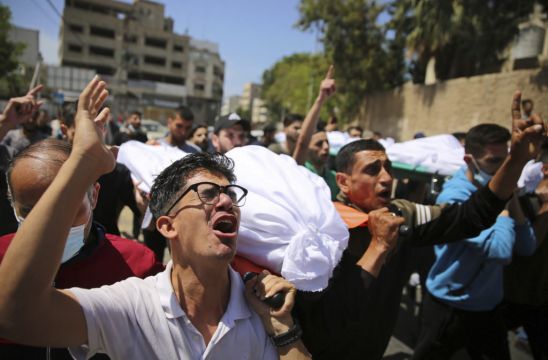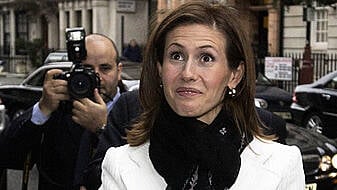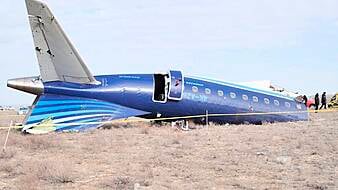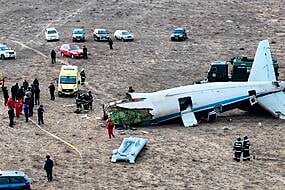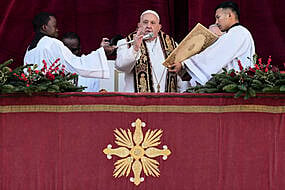Israeli airstrikes on Gaza City flattened three buildings and killed at least 42 people on Sunday, according to reports, as Israeli prime minister Benjamin Netanyahu signalled that fighting with the territory’s Hamas rulers would continue despite international efforts to broker a ceasefire.
In a televised address on Sunday, Mr Netanyahu said the attacks were continuing at “full force” and would “take time”.
Israel “wants to levy a heavy price” from Gaza’s militant Hamas rulers, the prime minister said, flanked by his defence minister and political rival, Benny Gantz, in a show of unity.

Hamas also pressed on, launching rockets from civilian areas in Gaza towards civilian areas in Israel.
One slammed into a synagogue in the southern city of Ashkelon hours before evening services for the Jewish holiday of Shavuot, Israeli emergency services said. No injuries were reported.
In the Israeli air assault early on Sunday, families were buried under piles of cement rubble and twisted steel. Shards of glass and debris covered streets close to the major city centre thoroughfare where the three buildings were hit over the course of five minutes around 1am.
The hostilities have repeatedly escalated over the past week, marking the worst fighting in the territory – that is home to two million Palestinians – since Israel and Hamas’ devastating 2014 war.
“I have not seen this level of destruction through my 14 years of work,” Samir al-Khatib, an emergency rescue official in Gaza, said. “Not even in the 2014 war.”
The Gaza health ministry said 16 women and 10 children were among those killed, with more than 50 people wounded.

Haya Abdelal, 21, lives in a building next to one that was destroyed and said she was sleeping when the airstrikes sent her fleeing into the street. She accused Israel of not giving its usual warning to residents to leave before launching such an attack.
“We are tired,” she said. “We need a truce. We can’t bear it anymore.”
An Israeli army spokesperson said the strike targeted Hamas “underground military infrastructure”.
As a result of the strike, “the underground facility collapsed, causing the foundation of the civilian houses above them to collapse as well, leading to unintended casualties”.
Gaza’s healthcare system, already gutted by an Israeli and Egyptian blockade imposed after Hamas seized power from rival Palestinian forces in 2007, had been struggling with a surge in coronavirus infections even before the latest conflict.
Earlier, the Israeli military said it had destroyed the home of Gaza’s top Hamas leader, Yahiyeh Sinwar, in a separate strike in the southern town of Khan Younis.
It was the third such attack on the homes of senior Hamas leaders, who have gone underground, in the last two days.
Israel appears to have stepped up strikes in recent days to inflict as much damage as possible on Hamas, as international mediators work to end the fighting.

But targeting the group’s leaders could hinder those efforts.
Israel has levelled a number of Gaza City’s tallest office and residential buildings in its airstrikes, alleging they contain Hamas military infrastructure. Among them was the high-rise property housing The Associated Press office and those of other media outlets.
The latest outbreak of violence began in east Jerusalem last month, when Palestinian protests and clashes with police broke out in response to Israeli police tactics during Ramadan and the threatened eviction of dozens of Palestinian families by Jewish settlers.
A focal point of clashes was the Al-Aqsa Mosque, a frequent flashpoint located on a hilltop compound that is revered by both Muslims and Jews.
Hamas fired rockets towards Jerusalem on Monday, triggering the Israeli assault on impoverished Gaza.
At least 188 Palestinians have been killed in Gaza, including 55 children and 33 women, with 1,230 people wounded. Eight people in Israel have been killed, including a five-year-old boy and a soldier.

Speaking alongside Mr Netanyahu on Sunday, Israel’s military chief, Lieutenant General Aviv Kochavi, said Hamas did not anticipate Israel’s overwhelming response to its rocket fire.
“Hamas made a serious and grave mistake and didn’t read us properly,” he said.
The turmoil has also spilled over elsewhere, fuelling protests in the occupied West Bank and stoking violence within Israel between its Jewish and Arab citizens, with clashes and vigilante attacks on people and property.
The violence also sparked pro-Palestinian protests in cities across Europe and the United States, with French police firing tear gas and water cannons at demonstrators in Paris.
Hamas and the Islamic Jihad militant group acknowledged that 20 fighters had been killed since violence broke out on Monday.
Israel said the real number was far higher and released the names and photos of two dozen alleged operatives it said were “eliminated”.

Hamas and other militant groups have fired some 2,900 rockets into Israel. The military said 450 of the rockets had fallen short or misfired, while Israeli air defences had intercepted 1,150.
The interception rate appeared to have significantly dropped since the start of the conflict, when Israel said 90% were intercepted.
Israel has meanwhile carried out hundreds of airstrikes across Gaza.
On Saturday, Israel bombed the 12-story al-Jalaa building, where the office of The Associated Press was located. The building also housed the TV network Al Jazeera and other media outlets, along with several floors of apartments.
“The campaign will continue as long as it is required,” Mr Netanyahu said. He alleged that Hamas military intelligence was operating inside the building.
Israel routinely cites a Hamas presence as a reason for targeting certain locations in airstrikes, including residential buildings. The military also has accused the militant group of using journalists as human shields, but provided no evidence to back up the claims.
Egypt and the US were involved in ceasefire efforts, but it was not clear if they were making progress, in light of Mr Netanyahu’s statement that the campaign was continuing.
The UN Security Council was also meeting on Sunday, and Secretary-General Antonio Guterres called for an end to the “senseless cycle of bloodshed, terror and destruction”.
